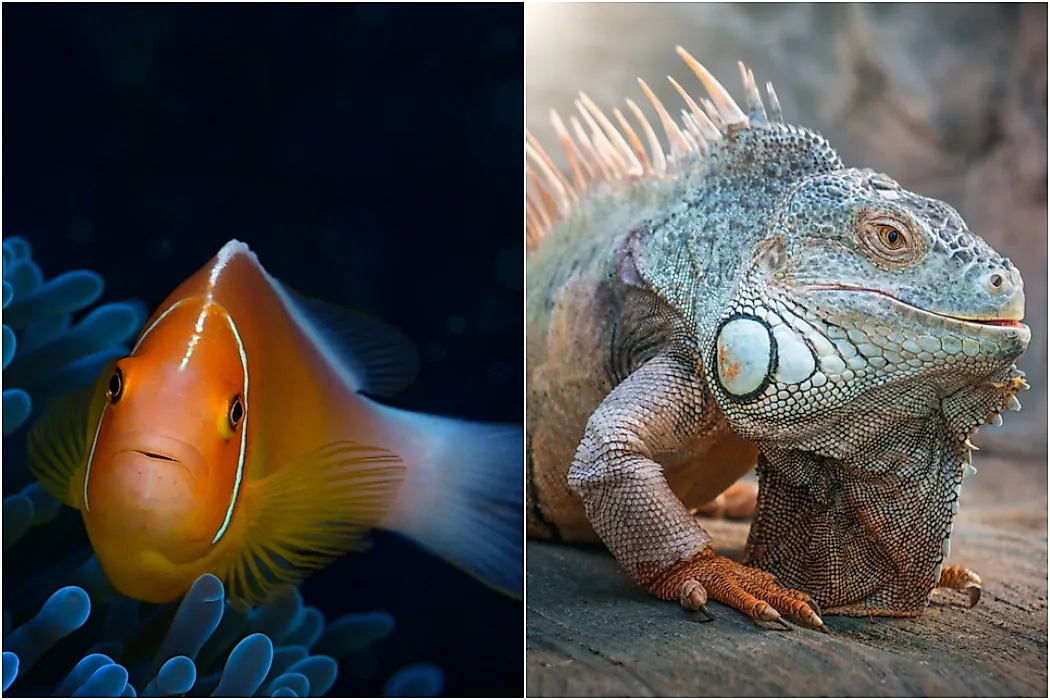Are Fish Reptiles?

The earliest animal that could be categorized as a fish was the soft-bodied chordate, which lived more than 500 million years ago during the Cambrian Period. Although the chordate did not have a true spine, it had notochords which made them more agile than other invertebrates. Some of these organisms evolved into the lobe-finned fish, which are ancestors of amphibians and reptiles. The earliest known reptile appeared about 312 million years ago during the Carboniferous Period. Therefore, fish are not reptiles since reptiles evolved from fish-like creatures which existed more than 370 million years ago.
Similarities Between Fish and Reptiles
Ectothermic animals
Reptiles and fish are both ectothermic (cold-blooded) animals whose internal sources of heat are insignificant and cannot regulate their body temperature. Therefore, their blood temperature changes with the temperature of the surrounding environment. They can survive in cold and warm environments, with some flourishing in warmer temperatures. Reptiles and fish are very active in warm temperatures.
Habitat
Fish live exclusively in water, while reptiles can survive both in water and on land. Some reptiles, like turtles and sea snakes, spend a significant percentage of their lives underwater and only swim to land to lay eggs. Others, like the crocodiles and alligators, spend their lives in marsh-lands and water. Both reptiles and fish hunt for fresh prey, but are always willing to consume dead plants and animals. Reptiles are omnivorous creatures, while the diets of fish vary by species. Many fish do not have teeth, and like reptiles, they consume their food whole.
Differences Between Fish and Reptiles
Reproduction
Most reptiles are oviparous creatures which lay eggs, although some give birth to live young. The eggs of reptiles are fertilized internally, which is not the case with fish. About 97% of all fish species develop eggs outside their bodies, with fertilization taking place externally. A few oviparous species, like skates and horn sharks, practice internal fertilization. The eggs of reptiles are usually hard and laid on land, while fish can lay soft-shelled eggs underwater.
Respiration
Reptiles breathe through their lungs, and cannot breathe underwater, except for turtles, which exchange limited gas especially during long periods of inactivity while in the sea. Fish breathe underwater through gills, which are composed of numerous threadlike structures called filaments. Fish also gulp air in through their mouth and exhale through their gills. Reptiles have skulls that have nasal openings and lungs which are ventilated through their axial musculature.
Locomotion
Most reptiles have small limbs which they use to move on land, while others, like snakes, are legless reptiles and move using their scales and muscles. Reptiles with legs can also use them to swim while underwater. Fish have ventral and dorsal fins, which they use for swimming. The fins are modified limbs that are adjusted for swimming.
Skin
Reptilian skin is tough, irregular, scaly, and water-tight, while fish skin has scales. However, cartilaginous fish do not have scales. Fish scales originate from the skin and resemble the structure of their teeth. Reptile skin has horny epidermis which is watertight, thus making it possible for them to survive on land. Reptiles also have scales to protect exposed parts of their skin.











